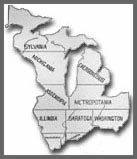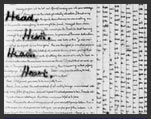The Early Republic, 1784-1789
1784
March 1. Jefferson submits to Congress his Report of a Plan of Government for the Western Territory, establishing procedures for the entrance of new states. In it, Jefferson proposes that slavery be abolished in new states by 1800. Congress rejects this part of the plan and passes the revised Ordinance April 23. Jefferson blames Southern representatives for Congress's rejection of his original plan. The Ordinance of 1784 marks the high point of Jefferson's opposition to slavery, which is more muted thereafter. Printed Resolutions on Western Territory, March 1, 1784
March. Jefferson drafts a report for reform of coinage that proposes replacing the English system of pounds sterling, shillings, and pence with a fraction or decimal system having an American version of the Spanish dollar as the basic unit. The reform does not pass Congress at this time, but it is adopted with some changes in 1786 and becomes effective several years later.
May 7. Congress appoints Jefferson minister plenipotentiary to join John Adams and Benjamin Franklin in negotiating treaties of amity and commerce with European nations. Jefferson eventually replaces Benjamin Franklin as minister to France. United States Congress, Instructions, May 1784
June-July. Jefferson travels throughout the eastern states, collecting information on their history, geography, agriculture, and commerce for his new role as minister in Europe.
July 5. Jefferson sails for Europe from Boston, accompanied by his twelve-year-old daughter Martha (Patsy) and William Short as personal secretary. James Hemings, his nineteen-year-old slave, follows soon after. William Short (1759-1849) is a young relative and protégé, who trained as a lawyer with George Wythe and served on the Executive Council of Virginia. James Hemings is the son of Betty Hemings and brother of Sally. Jefferson intends that he learn the art of French cooking in Paris.
August 3. Jefferson and his party arrive in Le Havre and travel on to Paris. Jefferson takes up residence first at the Hôtel de Landron and then at the Hôtel de Langeac on the Champs-Elysées. David Humphreys, secretary to commissioners Jefferson, Franklin, and Adams, joins Jefferson's household. Jefferson hires a Frenchman, Adrien Petit, to manage the household. At about the same time, Abigail Adams and her children John Quincy and Abigail arrive in Paris to join John Adams, who will be appointed the first ambassador to the Court of St. James's in London.
1785
April-May. John Adams and Jefferson successfully negotiate a loan from Dutch bankers to consolidate U. S. debts, pay long overdue salaries to French officer veterans of the American Revolution, and ransom American captives held by Algerian and Moroccan rulers who exact tribute from commercial shipping in the Mediterranean and hold hostage seamen of those countries unable or unwilling to pay.
Fall. Jefferson begins work with the Abbé Morellet on a French translation of his Notes on the State of Virginia. Having heard that a bad French translation is already in the works, Jefferson hopes to preempt it with his own. However, he is dissatisfied with Morellet's translation, published in 1787 as Observations sur la Virginie.
1786
January 7. Jefferson writes to New Hampshire governor John Sullivan, giving him directions on how to find and convey to Paris the skeleton and hide of a moose. Jefferson aims to refute the argument of famed French naturalist Georges de Buffon that nature, animals, and by implication humans in the New World are less developed and smaller in stature than those on the European continent. Thomas Jefferson to John Sullivan, January 7, 1786
January-March. Jefferson drafts a proposal to form a concert of powers led by the United States to oppose the North African regimes, known as the "Barbary Pirates," who levy tribute on American and European commercial ships. Friends present his proposal in Congress, but it is rejected because of its expense, as John Adams had predicted to Jefferson.
March-April. Jefferson visits the Adamses in London. John Adams and Jefferson take a tour of the English countryside. During his visit to London, Jefferson is presented at court and snubbed by King George III.
Late Summer. Jefferson is introduced to Maria Cosway by the American artist John Trumbull at the Halle aux Bleds, the French grain market in Paris. Cosway is a talented English artist, raised in Italy, and married to the miniaturist Richard Cosway. She and Jefferson develop a close personal relationship.
October 12. After recovering from a broken wrist, Jefferson writes Maria Cosway a carefully crafted letter in which his "Head" debates with his "Heart" the contesting merits of love and pleasure, on the one hand, and intellect and rationality, on the other. Jefferson's letterpress copy survives. Thomas Jefferson to Maria Hadfield Cosway, October 12, 1786
October-November. Jefferson learns of "Shay's Rebellion" in western Massachusetts, first from John Adams in a November 30 letter, and later from John Jay in an October 27 letter. The rebellion, led by Daniel Shays, is directed by Western debtor farmers against Eastern creditors and the courts. Abigail Adams, who corresponds regularly with Jefferson, also writes him about the insurgency, and Jefferson, who is not as alarmed as the Adamses, replies in a February 22, 1787, letter that "I like a little rebellion now and then. It is like a storm in the atmosphere." Thomas Jefferson to Abigail Adams, February 22, 1787
1787
March-June. Jefferson travels through the south of France and in northern Italy. Thomas Jefferson's drawing of a macaroni machine and instructions for making pasta.
May-September. The Constitutional Convention meets in Philadelphia, presided over by George Washington. Madison has been keeping Jefferson informed of the developments leading up to it, and Jefferson generally supports the effort. Under the Articles of Confederation, the government has the power to negotiate treaties but cannot regulate trade, and this has hampered Jefferson's efforts to negotiate commercial treaties with France. In November, Jefferson receives a copy of a draft of the Constitution and generally approves it, but urges Madison and others to add a bill of rights and to limit the number of terms that a president can serve.
July. Jefferson's other daughter, nine-year-old Mary (Polly), arrives in Paris with the fourteen-year-old slave, Sally Hemings. They first go to London, where they stay for a short while with John and Abigail Adams before proceeding to Paris.
1788
March-April. Jefferson travels through Holland and central Europe. June 19, he writes his "Hints to Americans Travelling in Europe" for Thomas Lee Shippen and John Rutledge Jr. (Shippen Family Papers, Manuscript Division, Library of Congress).
1789
May 5. Jefferson attends the opening of the French Estates-General and its debates at Versailles. The Estates-General have been called in the wake of the crown's increasing fiscal difficulties. Jefferson drafts a charter of rights with Lafayette in June. It serves as the basis for the French Declaration of Rights that Lafayette presents to the National Assembly in July.
July. Riots and mob actions, including the storming of the Bastille on July 14, occur in the streets of Paris. August, Lafayette and other French liberals meet secretly at Jefferson's home, the Hôtel de Langeac, just outside the city, to discuss a new French constitution.
September 26. The United States Senate confirms Jefferson's appointment as secretary of state in the administration of George Washington, first president of the United States.
September 28. Jefferson departs for home from the French port of Le Havre on board the Clermont. He does not learn of his appointment as secretary of state until he arrives in Norfolk, Virginia on November 23. On February 14, 1790 he accepts it reluctantly, because he had hoped to devote his time to Monticello and his private affairs.

Detail of map featured in "The Northwest and the Ordinances, 1783-1858," The History of the Upper Midwest: An Overview by Clarence Mondale, Emeritus Professor of American Civilization, The George Washington University, Summer, 1998.
![Detail of [Col. John Trumbull, half-length portrait]](images/trumbull.jpg)
![]()
![]() Detail of [Col. John Trumbull, half-length portrait]. Copy of painting by Waldo and Jewett. created/published c1912, [1912].
Detail of [Col. John Trumbull, half-length portrait]. Copy of painting by Waldo and Jewett. created/published c1912, [1912].

![]() Thomas Jefferson to Maria Hadfield Cosway, October 12, 1786. Library of Congress Manuscript Division
Thomas Jefferson to Maria Hadfield Cosway, October 12, 1786. Library of Congress Manuscript Division
